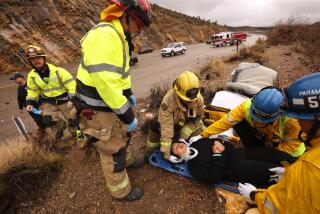Hospital Grounds Copter; One Air Ambulance Is Left
Western Medical Center of Santa Ana is canceling its 6-year-old helicopter ambulance service effective Friday, leaving Orange County with just one locally based air ambulance.
Orange County Fire Department paramedics, who rely upon helicopters to transport critically injured patients, said the move would not significantly hamper emergency medical care because another air helicopter based at UCI Medical Center in Orange is sufficient to cover the county.
‘Longer Response Time’
“It’s just gonna mean that firefighters working on emergency incidents are going to have to take into consideration a slightly longer response time for an air ambulance,” Orange County Fire Capt. Patrick MacIntosh said.
A company called Partners in LifeFlight, Southern California, operates the remaining air ambulance from UCI Medical Center. If that helicopter is tied up on another call, a backup is available at Memorial Medical Center in Long Beach, LifeFlight program coordinator Wendy Biggar said.
Biggar said the loss of the air ambulance program would be raised as an issue at the Jan. 7 meeting of the county’s helicopter advisory group. The group is a subcommittee of the county’s Emergency Medical Services Agency.
Betty O’Rourke, county EMS program manager, was not available for comment late Monday.
Termination of Western Medical Center’s Med Air ambulance service--announced two weeks ago to county health officials--comes in the face of high costs to operate the service, hospital President Wayne D. Schroeder said Monday.
It also comes six years after Western Medical Center, amid heavy media fanfare, inaugurated the county’s first locally based air ambulance program. At the time, Schroeder expressed confidence that the program would turn a profit so it could support itself.
Crash Set Program Back
The program suffered a major setback, though, when Med Air’s lone helicopter crashed near La Habra two years ago while transporting two accident victims to a hospital. No one was killed in the Jan. 26, 1986, accident, but the Med Air program was grounded for nearly a year and LifeFlight temporarily took its place.
The program was finally renewed only after hospital officials decided to contract out to a private company for a helicopter and crew. The hospital continued to provide its own nurses to accompany the emergency flights.
The program’s death blow came after a recent financial analysis by the hospital found that the Med Air operation has been losing $25,000 a month from patients who do not pay, Schroeder said. The helicopter service costs about $50,000 a month to run, he said.
“Our reimbursement rate is about 50%,” he said.
The cost analysis also revealed that Western Medical was footing all of patients’ air ambulance bills, regardless of where they were being transferred, Schroeder said.
Of the 374 patients transported by Med Air within the last year, he said, all but 100 were transported to hospitals other than Western Medical Center.
But Western Medical, as sole operator of the helicopter service, was left to collect bills from all the patients, Schroeder said.
With “severe cutbacks” in Medicare reimbursements in recent years, he said, Med Air’s ability to collect on those bills was worsened further.
No Other Choice
After reviewing these gloomy findings, Schroeder said, his hospital decided it had no choice but to back out of the helicopter program.
“We can’t afford to carry the other hospitals,” he said.
Med Air’s 15 nursing and support staff members were given the bad news two weeks ago. They are to learn today whether the hospital will absorb them into other departments, as some have requested.
“I know they are sorry to see something that served a need in the county go under,” said Leslee O’Brien, director of the Med Air program since its inception. “I know there have been other times when money has been a consideration, and we’ve always seemed to weather it. This time we didn’t.”
O’Brien said Med Air operated an average of 30-35 flights per month, roughly divided between medical emergencies at accident scenes and transporting patients from one hospital to another. LifeFlight, by comparison, responds to about 100 calls per month in the county, mostly involving hospital transfers, pilots there said.
Western Medical Center has left the door open for helicopter companies to submit bids to the hospital so a service can be restarted. Such a service would be financially supported by all the hospitals that use it.
Optimism on New Service
Helicopter Air Transport, an Oregon-based company that contracted a helicopter and crew for the Med Air program, will be among “three to four” companies invited to submit bids, Schroeder said.
If one of those companies comes up with an attractive package, Western Medical will allow it to use the hospital’s heliport facilities as a base, he said.
Schroeder said he is optimistic that a new service will be up and running within two months.
But some members of the local medical community questioned whether the county needs more than one locally based air ambulance. “LifeFlight can cover the county easily,” said Dr. Brian Palafox, a surgeon at the UCI Medical Center trauma center.
Joe Parr, a LifeFlight pilot, said he can fly anywhere in the county within a matter of minutes.
But O’Brien said there are times when both the LifeFlight helicopter based in Orange and the one based in Long Beach are busy on other calls, and there is no backup.
“Every service needs a backup,” she said. “We will have to wait and see if another provider can fill the need.”
More to Read
Sign up for Essential California
The most important California stories and recommendations in your inbox every morning.
You may occasionally receive promotional content from the Los Angeles Times.










